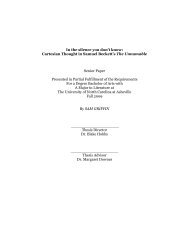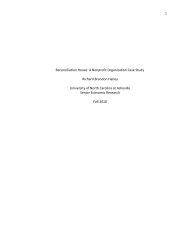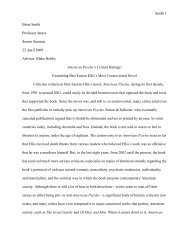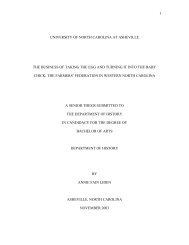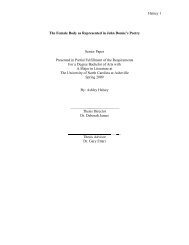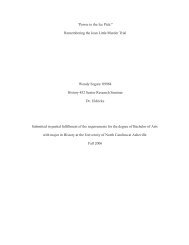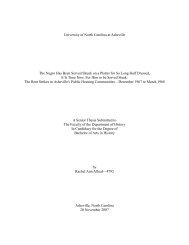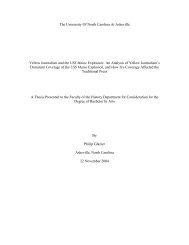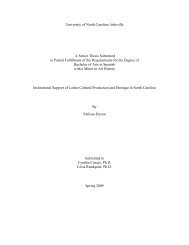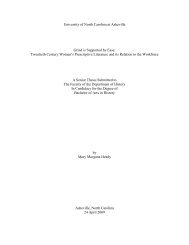To Test an Idea: Menippean Satire in Lawrence Durrell's Avignon ...
To Test an Idea: Menippean Satire in Lawrence Durrell's Avignon ...
To Test an Idea: Menippean Satire in Lawrence Durrell's Avignon ...
Create successful ePaper yourself
Turn your PDF publications into a flip-book with our unique Google optimized e-Paper software.
<strong>To</strong> <strong>Test</strong> <strong>an</strong> <strong>Idea</strong>:Menippe<strong>an</strong> <strong>Satire</strong> <strong>in</strong> <strong>Lawrence</strong> Durrell’s <strong>Avignon</strong> Qu<strong>in</strong>tetSenior PaperPresented <strong>in</strong> Partial Fulfillment of the RequirementsFor a Degree Bachelor of Arts withA Major <strong>in</strong> Literature atThe University of North Carol<strong>in</strong>a at AshevilleFall 2009By JACOB RILEY____________________Thesis DirectorDr. Blake Hobby____________________Thesis AdvisorDr. Michael Gillum
Riley 2Philosophical ideas <strong>an</strong>imate Durrell’s writ<strong>in</strong>g, yet Durrell does not aspire to philosophy. Headmits <strong>in</strong> a Key to Modern British Poetry that he is “[d]eficient <strong>in</strong> true scholarship” <strong>an</strong>d has “onlybeen able to br<strong>in</strong>g to the job only a wide haphazard read<strong>in</strong>g” (x). Durrell proclaims: “The materialswe use for th<strong>in</strong>k<strong>in</strong>g are so unstable that it is unlikely we shall ever reach a f<strong>in</strong>al def<strong>in</strong>ition [. . .] Yetwe are forced to use them. There is no f<strong>in</strong>al truth to be found—there is only provisional truthwith<strong>in</strong> a given context” (3). Durrell’s works deal with relationships <strong>an</strong>d the ability we have—both asbe<strong>in</strong>gs liv<strong>in</strong>g <strong>in</strong> the world <strong>an</strong>d as readers encounter<strong>in</strong>g a text— to negotiate relative me<strong>an</strong><strong>in</strong>g, seelife’s general deficiencies, <strong>an</strong>d arrive at pragmatic truths. Durrell depicts his characters <strong>in</strong>tellectualsystematizations as necessary charades <strong>in</strong> order to test <strong>an</strong> idea. Durrell’s works lead characters toweigh options, see reality as perspectival, <strong>an</strong>d arrive at concrete decisions. Such a malleability ofthought <strong>an</strong>d l<strong>an</strong>guage c<strong>an</strong> not only be found <strong>in</strong> Durrell’s writ<strong>in</strong>g but also <strong>in</strong> works of literaturebroadly categorized as Menippe<strong>an</strong> satire, a l<strong>in</strong>k not yet explored <strong>in</strong> Durrell criticism. Argu<strong>in</strong>g thatDurrell’s works function <strong>in</strong> a Menippe<strong>an</strong> mode, I will explore the porous nature of thought <strong>an</strong>didentity <strong>in</strong> The <strong>Avignon</strong> Qu<strong>in</strong>tet.Menippe<strong>an</strong> satire has been a fluid category s<strong>in</strong>ce its <strong>an</strong>cient beg<strong>in</strong>n<strong>in</strong>gs. Accord<strong>in</strong>g to NorthropFrye <strong>in</strong> Anatomy of Criticism, Menippe<strong>an</strong> satire is “a prose form” with a recurrent feature of“<strong>in</strong>cidental verse” (309). However, Frye attempts to p<strong>in</strong> down other aspects of Menippe<strong>an</strong> <strong>Satire</strong>:The Menippe<strong>an</strong> satire deals less with people as such th<strong>an</strong> with mental attitudes [. . .]The Menippe<strong>an</strong> satire thus resembles the confession <strong>in</strong> its ability to h<strong>an</strong>dle abstractideas <strong>an</strong>d theories <strong>an</strong>d differs from the novel <strong>in</strong> its characterization, which is stylizedrather th<strong>an</strong> naturalistic, <strong>an</strong>d presents people as mouthpieces of the ideas theyrepresent. (310)
Riley 3Though none of the works of Menippus survive, m<strong>an</strong>y works cont<strong>in</strong>ued the tradition heestablished. Frye considers works such as Gulliver’s Travels, C<strong>an</strong>dide, Garg<strong>an</strong>tua <strong>an</strong>d P<strong>an</strong>tagruel,<strong>an</strong>d even Brave New World as works of fiction, but not novels (308). Likewise, it is difficult to callDurrell’s <strong>Avignon</strong> Qu<strong>in</strong>tet a novel.Northrop Frye laments that certa<strong>in</strong> works of fiction have been misunderstood because they arenot recognized as Menippe<strong>an</strong> <strong>Satire</strong>: “a clearer underst<strong>an</strong>d<strong>in</strong>g of the form <strong>an</strong>d traditions of the<strong>an</strong>atomy would make a good m<strong>an</strong>y elements <strong>in</strong> the history of literature come to focus [. . .] thereare m<strong>an</strong>y [. . .] <strong>an</strong>atomies that are neglected only because the categories to which they belong areunrecognized” (Frye 312). For <strong>in</strong>st<strong>an</strong>ce, <strong>in</strong> Menippe<strong>an</strong> <strong>Satire</strong>, “[t]he <strong>in</strong>tellectual structure built upfrom the story makes for violent dislocations <strong>in</strong> the customary logic of narrative, though theappear<strong>an</strong>ce of carelessness that results reflects on the carelessness of the reader or his tendency tojudge by a novel-centered conception of fiction” (310). Critics have often struggled with thestructure of the Qu<strong>in</strong>tet. Melody L. Enscore <strong>in</strong> “Systematic Imagery <strong>in</strong> Durrell’s <strong>Avignon</strong> Qu<strong>in</strong>tet”suggests that the Qu<strong>in</strong>tet’s images compose the complex structure that gives the work a coherentme<strong>an</strong><strong>in</strong>g: “the destruction <strong>an</strong>d reconstruction of established groups of characters, narrativeperspectives, ideologies, <strong>an</strong>d images are essential patterns that c<strong>an</strong> lead one [. . .] to a coherentunderst<strong>an</strong>d<strong>in</strong>g of Durrell’s most challeng<strong>in</strong>g work” (152). In contrast, Ann Gibaldi <strong>in</strong> “Entropy <strong>in</strong><strong>Lawrence</strong> Durrell’s <strong>Avignon</strong> Qu<strong>in</strong>tet: Theme <strong>an</strong>d Structure <strong>in</strong> Sebasti<strong>an</strong> <strong>an</strong>d Qu<strong>in</strong>x,” argues thatDurrell’s conscious lack of structure reflects his st<strong>an</strong>ce on the reversal of chaos through submissionto entropy: “[Durrell] refuses to impose a highly formalized <strong>an</strong>d recognizable structure on theQu<strong>in</strong>tet. Instead he chooses a structure that is chaotic, submitt<strong>in</strong>g to entropy with the faith thatthrough this submission <strong>an</strong> underly<strong>in</strong>g pattern or structure will reveal itself” (104). Another critic,Sus<strong>an</strong> V<strong>an</strong> der Closter argues that the Qu<strong>in</strong>tet is structured like a Medieval polyptych,
Riley 5with the possibility of split personality)” (117). The relationship between Bl<strong>an</strong>ford <strong>an</strong>d Sutcliffemost clearly illustrates this k<strong>in</strong>d of dialogic treatment of selfhood.Durrell’s conflation of fiction <strong>an</strong>d reality complicates the relationship between Sutcliffe <strong>an</strong>dBl<strong>an</strong>ford. The text suggests that Sutcliffe is the fictional creation of the author Bl<strong>an</strong>ford.However, <strong>in</strong> Const<strong>an</strong>ce, Sutcliffe breaks through his fictional position <strong>an</strong>d enters Bl<strong>an</strong>ford’s realm,caus<strong>in</strong>g us to question the ground of fictional “reality.” Throughout the work, they engage <strong>in</strong>humorous self-conscious discussions about the nature of art, their own literary projects, <strong>an</strong>d otherissues, as separate entities. As Bakht<strong>in</strong> writes, “this unf<strong>in</strong>alizability of a m<strong>an</strong> [. . .] [is] still ratherelementary <strong>an</strong>d embryonic <strong>in</strong> the menippea, but are openly there <strong>an</strong>d permit us to look at a person<strong>in</strong> a new way” (117). Bakht<strong>in</strong> me<strong>an</strong>s that, unlike characters <strong>in</strong> the novel, the other personality isrepresented as <strong>an</strong>other entity rather th<strong>an</strong> a part of the psyche. Julius Row<strong>an</strong> Raper recognizesSutcliffe <strong>an</strong>d Bl<strong>an</strong>ford’s bond <strong>in</strong> “ The Philosopher’s Stone <strong>an</strong>d Durrell’s Psychological Vision.” Hecalls Sutcliffe “a fictional mirror of the cynical, skeptical, self-critical, yet earthy side of Bl<strong>an</strong>fordhimself” (142). Accord<strong>in</strong>g to Raper, even though Sutcliffe is represented as a separate body, he issymbolically the other half of Bl<strong>an</strong>ford’s psyche.Taken together as one self, we c<strong>an</strong> underst<strong>an</strong>d Sutcliffe <strong>an</strong>d Bl<strong>an</strong>ford as represent<strong>in</strong>g what Fryecalls the philosophus gloriosus: “The novelist sees evil <strong>an</strong>d folly as social diseases, but the Menippe<strong>an</strong>satirist sees them as diseases of the <strong>in</strong>tellect, as a k<strong>in</strong>d of maddened ped<strong>an</strong>try which the philosophusgloriosus at once symbolizes <strong>an</strong>d def<strong>in</strong>es” (309). Follow<strong>in</strong>g Frye’s def<strong>in</strong>ition, Millowicki <strong>an</strong>d Wilson<strong>in</strong> “A Measure for Menippe<strong>an</strong> Discourse: The Example of Shakespeare” elaborate upon thefunction of the philosophus gloriosus: “Menippe<strong>an</strong> discourse asserts then denies; holds up high, thentears down. This is nowhere more apparent th<strong>an</strong> <strong>in</strong> [. . .] the philosophus gloriosus, who undercuts<strong>in</strong> reflexive second thoughts <strong>an</strong>d meta-commentary, his own <strong>in</strong>tellectual achievements” (302). The
Riley 6meta-commentary on Bl<strong>an</strong>ford’s thoughts presents itself through his dialogues with Sutcliffe. For<strong>in</strong>st<strong>an</strong>ce, <strong>in</strong> Livia, Sutcliffe accuses Bl<strong>an</strong>ford of us<strong>in</strong>g art to express theories. He gro<strong>an</strong>s <strong>an</strong>d says“The old d<strong>an</strong>ger is there—a work weighed down with theoretical considerations” (Livia 11). ButBl<strong>an</strong>ford sees the d<strong>an</strong>ger <strong>an</strong>d denies that his project is a theoretical treatise. For all of thephilosophical <strong>an</strong>d religious ideas explored <strong>in</strong> the Qu<strong>in</strong>tet, the work does not primarily questionideas’ <strong>in</strong>dependent truth. Instead, Durrell primarily questions the construction of the self throughsuch ideas. As Sutcliffe says to Bl<strong>an</strong>ford,What always bothered me was the question of a stable ego—did such a th<strong>in</strong>g exist?The old notion of such <strong>an</strong> <strong>an</strong>imal was rather primitive, particularly for novelistswith <strong>an</strong> itch to expla<strong>in</strong> this action or that. Myself, I could hardly write down thename of a character without suddenly be<strong>in</strong>g swamped by <strong>an</strong> oce<strong>an</strong> of possibleattributes, each as valid <strong>an</strong>d as truthful as <strong>an</strong>y other. (Livia 37)Durrell’s commitment to the question of the self refutes the claim that Durrell’s project exists <strong>in</strong>the abstract realm of philosophical ideas.Such is the problem with postmodern critiques such as the one found <strong>in</strong> Stef<strong>an</strong>Herbrechter’s <strong>Lawrence</strong> Durrell, Postmodernity, <strong>an</strong>d the Ethics of Alterity. Us<strong>in</strong>g dense philosophicaltexts, Herbrechter critiques one of the systems laid on <strong>in</strong> the Qu<strong>in</strong>tet, Gnosticism, for its aspirationto the One over the Other: “S<strong>in</strong>ce this system of thought always starts from the One <strong>an</strong>d—after aplayful detour—returns to the One, the plural rema<strong>in</strong>s a purely <strong>in</strong>termediary step. It is thus notautonomously plural but plural towards or ‘for’ the One” (116). In a similar philosophical <strong>an</strong>alysis,Ramón P. Alastrué’s “Chaos <strong>an</strong>d Cosmos <strong>in</strong> The <strong>Avignon</strong> Qu<strong>in</strong>tet” claims that the <strong>Avignon</strong>Qu<strong>in</strong>tet resolves its several dualisms (East/West, Male/Female, Creator/Created) through its questfor a Center able to harmonize chaos <strong>an</strong>d cosmos. For <strong>in</strong>st<strong>an</strong>ce, Alastrué reads the f<strong>in</strong>al journey
Riley 7<strong>in</strong>to the cave at the end of Qu<strong>in</strong>x as “a way both <strong>in</strong>to the <strong>in</strong>escapable labyr<strong>in</strong>th of a closed fictionalsystem <strong>an</strong>d out of the labyr<strong>in</strong>th, onto a superior ontological pl<strong>an</strong>e: what the external narrator callsthe realm of unpredictability [. . .] the external world” (Alastrué 124). However, Durrell’s <strong>Avignon</strong>Qu<strong>in</strong>tet critiques such clear dist<strong>in</strong>ctions between reality <strong>an</strong>d fiction. Thus, it is difficult to agreewith Alastrué that the Qu<strong>in</strong>tet offers “a possibility of tr<strong>an</strong>scend<strong>in</strong>g the fictional nature of fiction<strong>an</strong>d the historical nature of history” (124). Rather, it forces the reader to recognize reality’sdependence on fictions.While Alastrué f<strong>in</strong>ds harmony on a superior ontological pl<strong>an</strong>e, Paul Lorenz suggests <strong>an</strong> <strong>in</strong>nertr<strong>an</strong>sformation as a mode of tr<strong>an</strong>scendence <strong>in</strong> “Angkor Wat, the Kundal<strong>in</strong>i, <strong>an</strong>d the Qu<strong>in</strong>x: TheHum<strong>an</strong> Architecture of Div<strong>in</strong>e Renewal <strong>in</strong> the Qu<strong>in</strong>cunx.” He claims that we musttap the power of the cosmos <strong>an</strong>d achieve a metamorphosis of consciousness thatwill ensure the cont<strong>in</strong>uation of hum<strong>an</strong> life is a disengagement from the l<strong>in</strong>earity <strong>an</strong>dhierarchal structures of the Indo-Europe<strong>an</strong> worldview. In this way, we, as hum<strong>an</strong>be<strong>in</strong>gs, c<strong>an</strong> achieve the power of the Buddha. (167)While it is true that Durrell tended toward Eastern thought, with<strong>in</strong> the <strong>Avignon</strong> Qu<strong>in</strong>tet, Easternthought is not presented as a p<strong>an</strong>acea for all hum<strong>an</strong> problems. As William Godshalk po<strong>in</strong>ts out <strong>in</strong>“<strong>Lawrence</strong> Durrell’s Game <strong>in</strong> The <strong>Avignon</strong> Qu<strong>in</strong>tet,” eastern practices like yoga are first presented<strong>in</strong> a positive light, but then playfully put <strong>in</strong>to question. In Qu<strong>in</strong>x, the narrator writes that “Sutcliffewas right to reproach [Bl<strong>an</strong>ford] with all the bra<strong>in</strong> weary<strong>in</strong>g lumber he had taken aboard--all thissoul-porridge, all this bra<strong>in</strong>-mash of H<strong>in</strong>du soul-fuck” (Qu<strong>in</strong>x 166 qtd. <strong>in</strong> Godshalk 196).Though such ideas <strong>in</strong> themselves as Gnosticism <strong>an</strong>d Eastern Wisdom are me<strong>an</strong><strong>in</strong>gless, as<strong>in</strong>terpreted by characters, these systems of thought become part of a character’s self-construction.Durrell’s characters are not primarily composed of actions, but by their unique adoption of ideas.
Riley 8Jim Nichols <strong>in</strong> “Ah the Wonder of My Body: The W<strong>an</strong>der<strong>in</strong>g of My M<strong>in</strong>d: Classicism <strong>an</strong>d<strong>Lawrence</strong> Durrell’s Literary Tradition,” claims that for Durrell “all knowledge is a well from which<strong>in</strong>dividuals draw, <strong>an</strong>d such knowledge is neither <strong>in</strong>herently evil nor good but specific to thesituation, the persons, <strong>an</strong>d their dem<strong>an</strong>ds” (Nichols 452). Therefore, the reader must take <strong>in</strong>toaccount the effects of the knowledge characters receive.If Durrell’s ideas were divorced from the characters that affirm them, these ideas would formstable systems, mak<strong>in</strong>g the <strong>Avignon</strong> Qu<strong>in</strong>tet a work of diluted philosophy. However, Durrell is first<strong>an</strong>d foremost a fiction writer. <strong>To</strong> illustrate the contrast between philosophy <strong>an</strong>d Menippe<strong>an</strong> satire,Bakht<strong>in</strong> argues that, unlike Plato’s dialogues, <strong>in</strong> Menippe<strong>an</strong> satire “complex <strong>an</strong>d extensive modes ofargumentation [. . .] fell away, <strong>an</strong>d there rema<strong>in</strong>ed essentially only naked ‘ultimate questions’ with<strong>an</strong> ethical <strong>an</strong>d practical bias” (Problems 117). Thus, Menippe<strong>an</strong> satire often ridicules stable,systematic accounts of reality.Menippe<strong>an</strong> <strong>Satire</strong> questions <strong>an</strong>y abstract system’s claim to truth because ideas about truthch<strong>an</strong>ge with<strong>in</strong> different contexts. Durrell writes, “So it is with ideas, <strong>an</strong>d with the words we use toexpress them. Exist<strong>in</strong>g s<strong>in</strong>gly, they also have the power to modify, <strong>an</strong>d form greater wholes <strong>in</strong> othercontexts” (Key 3). Durrell goes on to write “The relations we see, or th<strong>in</strong>k we see, between ideas,are only useful if we use them as spr<strong>in</strong>g-boards from which to jump <strong>in</strong>to reality ourselves” (Key 39).If those ideas are adhered to dogmatically as <strong>an</strong> eternal Truth, they h<strong>in</strong>der rather th<strong>an</strong> help thecharacters construction of the self <strong>an</strong>d surround<strong>in</strong>g reality. In Monsieur, Sylvie senses this d<strong>an</strong>gerwhen she warns Akkad about Piers’ temperament: “Akkad, don’t encourage Piers to take all thistoo seriously [. . .] He is far too quixotic, far too extreme. It would be very d<strong>an</strong>gerous forsomebody with his type of temperament” (Monsieur 150). Piers refutation is that he would “go tothe stake for this,” which illustrates Sylvie’s po<strong>in</strong>t.
Riley 9Piers has <strong>an</strong> <strong>in</strong>tellectual temperament that leads him to <strong>in</strong>tense theoretical study ofGnosticism, a major ideology questioned by the text. But though Piers devotes himself to thetheoretical study, he does not adhere to core pr<strong>in</strong>ciples of Gnosticism. The Gnostics supposedlyshun the world of matter for a more poetic existence. Akkad labels all Judeo-Christi<strong>an</strong> religions asa form of slavery to matter: “The presid<strong>in</strong>g demon is the spirit of matter, <strong>an</strong>d he spr<strong>in</strong>gs fullyarmed from the head of classical Judaism of which all Europe<strong>an</strong> religions are tributaries. Thepr<strong>in</strong>ce is usury, the spirit of ga<strong>in</strong>, the enigmatic power of capital value embodies <strong>in</strong> the poetry ofgold” (Monsieur 144-45). However, shortly after his study<strong>in</strong>g, Piers goes on a pleasure cruise withthree of his friends. Bruce is shocked by the abund<strong>an</strong>ce of Piers supplies: “you would have thoughtwe were mount<strong>in</strong>g <strong>an</strong> expedition to Polynesia to judge by the qu<strong>an</strong>tity of the stores which heordered” (Monsieur 154). Despite all of Akkad’s theoretical expositions, Akkad is not <strong>an</strong> ascetichermit but a successful bus<strong>in</strong>essm<strong>an</strong> who accepts <strong>an</strong>d thrives <strong>in</strong> a world he claims is evil. Hisblat<strong>an</strong>t participation <strong>in</strong> the world of matter underm<strong>in</strong>es his discourse on the spirit. First describedas a “merch<strong>an</strong>t-b<strong>an</strong>ker,” Akkad is “equally at home <strong>in</strong> four capitals <strong>an</strong>d four l<strong>an</strong>guages” (107).Sometimes he looks like “a fattish sluggish pasha, wallow<strong>in</strong>g <strong>in</strong> riches like a Turk,” other times“[b]eautifully dressed by London with a buttonhole <strong>an</strong>d a silk h<strong>an</strong>dkerchief” (107). Akkad’schameleon like existence may suggest that the theoretical underp<strong>in</strong>n<strong>in</strong>gs of Gnosticism,particularly the b<strong>in</strong>ary between Judaism <strong>an</strong>d Gnosticism, may only be a helpful myth rather th<strong>an</strong> adogmatic truth. Indeed, after his theoretical exposition of Gnosticism, the nature of truth isentirely put <strong>in</strong>to question. Akkad tests Piers’ faith by <strong>in</strong>sert<strong>in</strong>g a fake article about how the entiresect was created by crim<strong>in</strong>als <strong>in</strong> order to take adv<strong>an</strong>tage of gullible tourists. Piers is relieved to f<strong>in</strong>dthat Akkad pl<strong>an</strong>ted the article, but seems to miss the greater po<strong>in</strong>t Akkad tries to make. Akkadfully admits that there are aspects of the article that could be considered true: “you could question
Riley 10m<strong>an</strong>y th<strong>in</strong>gs about our group <strong>an</strong>d we would be unable to provide conv<strong>in</strong>c<strong>in</strong>g expl<strong>an</strong>ations to rebutyou” (Monsieur 174). Indeed, his own actions reflect that he does not take his theoreticalexplication as <strong>an</strong> essential doctr<strong>in</strong>e for life. In <strong>an</strong>other attempt to expla<strong>in</strong> his beliefs, he tells Piers“not to live accord<strong>in</strong>g to a prearr<strong>an</strong>ged pl<strong>an</strong> or model, but to improvise” (Monsieur 173). Akkad’stwo different formulations of belief show the <strong>in</strong>herent <strong>in</strong>stability of the Gnostic system.Furthermore, Akkad’s alternate exposition of Gnosticism suggests that Gnosticism tr<strong>an</strong>scendsits systematic expl<strong>an</strong>ation. Reed Way Dasenbrock <strong>in</strong> “The Counterlife of Heresy” reads Akkad’sfake article as a serious warn<strong>in</strong>g to Piers that “the accept<strong>an</strong>ce of <strong>an</strong>y order<strong>in</strong>g or system ofexpl<strong>an</strong>ation, even a heretical one, produces the fatal quiescence of orthodoxy” (228). Unquestionedaccept<strong>an</strong>ce of all Gnostic doctr<strong>in</strong>e is <strong>an</strong>tithetical to the very spirit of Gnosticism. Before Akkad’shoax, Piers did not really underst<strong>an</strong>d the Gnostic attitude; he still thought that it could beunderstood through books. He says to Bruce, “I’ve hit bedrock with this system, <strong>an</strong>d I feel I shallgo to the end of it, I feel it” (166). Dasenbrock argues “Akkad’s disturb<strong>an</strong>ce of Piers’ easyaccept<strong>an</strong>ce of his <strong>in</strong>itiation <strong>in</strong>to Gnosticism is, therefore, Piers’ real <strong>in</strong>itiation <strong>in</strong>to Gnosticism”(228). Dasenbrock concludes his <strong>an</strong>alysis with a comparison between Durrell’s <strong>an</strong>d Akkad’simprovisational methods: “Durrell plays with our belief <strong>in</strong> the reality of what is be<strong>in</strong>g narrated justas Akkad plays with Piers’ belief <strong>in</strong> his own <strong>in</strong>itiation. And this constitutes our <strong>in</strong>itiation <strong>in</strong>to thecounterlife of art, a creative improvisation which refuses the world even as it redeems it” (228).Thus, <strong>in</strong> one version of Akkad’s thought, the Gnostic should cont<strong>in</strong>ually question aspects ofGnosticism.Tak<strong>in</strong>g his cue from Akkad, James Gifford questions the sources of Akkad’s Gnosticism.Most critics have assumed that Durrell pulled his ideas from Lacarriere’s The Gnostics. However,<strong>in</strong> “Gnosticism <strong>in</strong> <strong>Lawrence</strong> Durrell’s Monsieur: New Textual Evidence for Source Materials,”
Riley 11Gifford po<strong>in</strong>ts out <strong>an</strong> import<strong>an</strong>t difference between Durrell’s representation <strong>an</strong>d Lacarriere’s. InDurrell’s Gnosticism, a str<strong>an</strong>ge ritualistic suicide is the culm<strong>in</strong>ation of the Gnostic’s primaryalienation from the world: “to the pure [G]nostic soul the open gesture of refusal is necessary, isthe only poetic act” (144). In contrast, for Lacarriere, suicide “is the absolute <strong>an</strong>tithesis of theGnostic attitude. Not one of them, at <strong>an</strong>y time, preached suicide” (Lacarriere qtd. <strong>in</strong> Gifford 2).Gifford argues this difference is accounted for by one of Durrell’s notebooks with a newspaperclipp<strong>in</strong>g of <strong>an</strong> article:The article describes the suicides of six young people, which occurred <strong>in</strong> quicksuccession <strong>in</strong> the Sloveni<strong>an</strong> capital of Ljublj<strong>an</strong>a <strong>in</strong> 1968. The suicides, because oftheir rapidity <strong>an</strong>d the proximity of all those <strong>in</strong>volved, were quickly rumored to bethe result of a “suicide club” <strong>an</strong>d this notion was well publicized <strong>in</strong> the <strong>in</strong>ternationalpress at the time [. . .] the article itself conta<strong>in</strong>s no mention or even suggestion thatthe suicides were <strong>in</strong> <strong>an</strong>y way connected to Gnosticism.” (Gifford 3)It appears as though Durrell comb<strong>in</strong>ed this suicide club event with the Gnostic refusal of theworld. Gifford th<strong>in</strong>ks that this underm<strong>in</strong>es some scholars’ read<strong>in</strong>gs that Gnostic suicide is a realoption ; rather it “is quite plausibly a satiric element <strong>in</strong> the work” (Gifford 6).Support<strong>in</strong>g his position that suicide <strong>in</strong> <strong>an</strong> untenable option for Durrell, Gifford argues <strong>in</strong>“The Phenomenology of Death: Consider<strong>in</strong>g Otto R<strong>an</strong>k, Ernest Becker <strong>an</strong>d Herbert Marcuse <strong>in</strong><strong>Lawrence</strong> Durrell’s <strong>Avignon</strong> Qu<strong>in</strong>tet,” that Gnostic suicide ‘colonizes’ (controls) death by accept<strong>in</strong>gthe death of the body <strong>in</strong> exch<strong>an</strong>ge for a resolution to our <strong>an</strong>xiety about death: “The death of theself (the primary <strong>an</strong>xiety) is projected onto the unreal exterior body (death of the body), henceresolv<strong>in</strong>g the <strong>an</strong>xiety over mortality, but creat<strong>in</strong>g the life-limit<strong>in</strong>g disda<strong>in</strong> for physicality” (Gifford).In this way, the Gnostic seeks to ‘know’ death <strong>in</strong>stead of believ<strong>in</strong>g there is, as Akkad puts it, “a very
Riley 12narrow path between reality <strong>an</strong>d illusion” (Monsieur 172). Aga<strong>in</strong>st Gifford, C.W. Sp<strong>in</strong>ks contrastsGnostic despair with rom<strong>an</strong>tic despair, imply<strong>in</strong>g that Gnostic despair does not provide comfort:“Akkad is not offer<strong>in</strong>g just rom<strong>an</strong>tic despair, <strong>an</strong>d the despair here offered is repeatedly described as[G]nostic despair—someth<strong>in</strong>g that would deny all the comfort of such existential despair” (130).But Gifford’s philosophical <strong>an</strong>alysis underm<strong>in</strong>es Sp<strong>in</strong>ks’ unsupported position. Furthermore, ifGnostic suicide is really <strong>an</strong> Aufhebung of the discrete ego rather th<strong>an</strong> its <strong>an</strong>nihilation, we c<strong>an</strong>notseriously consider it to be <strong>an</strong> option for Durrell, who cont<strong>in</strong>ually fought aga<strong>in</strong>st this conception ofthe self. Both of Gifford’s articles strongly suggest the possibility that Gnostic suicide is a part ofthe Qu<strong>in</strong>tet’s satirical vision.Gifford’s genetic criticism <strong>an</strong>d his thorough research <strong>in</strong>to philosophical psychology givesmore credence to <strong>To</strong>by’s declaration that Akkad’s cult is “noth<strong>in</strong>g but a grubby little suicideacademy [. . .] a sort of ungraduated colourless hopelessness about the very fabric <strong>an</strong>d structure ofour thought, our universe” (Monsieur 255). Gifford’s <strong>an</strong>alysis also helps to support the m<strong>an</strong>y criticswho have already po<strong>in</strong>ted out the <strong>in</strong>sufficiency of Gnosticism. James P. Carley <strong>in</strong> “The <strong>Avignon</strong>Qu<strong>in</strong>tet <strong>an</strong>d the Gnostic Heresy” writes,Although the Gnostic systems are replete with symbols of reconciliation,[G]nosticism itself c<strong>an</strong>not be taken as a p<strong>an</strong>acea for the problems of western society[. . .] [G]nosticism is a reaction, not <strong>an</strong> absolute [. . .] Beyond its own world ofmirrors <strong>an</strong>d <strong>an</strong>titypes [G]nosticism must be evaluated by me<strong>an</strong>s of the reflectionsof yet <strong>an</strong>other look<strong>in</strong>g glass. (235)In <strong>an</strong> <strong>in</strong>terview of James P. Carly, Durrell said that Gnosticism was “a disease caused by theChristi<strong>an</strong> context”; as “the opposite extreme, [[G]nosticism] is a renunciation which makes senseonly <strong>in</strong> the context of a reaction” (Durrell qtd. <strong>in</strong> Herbrechter 64). Thus, if Gnosticism is a system
Riley 13that reacts aga<strong>in</strong>st Christi<strong>an</strong>ity, then, when dogmatically adhered to <strong>in</strong> all its aspects, it is asdestructive as Christi<strong>an</strong>ity.This mock<strong>in</strong>g of the seriousness of religion is <strong>an</strong>other characteristic of Menippe<strong>an</strong> satire.Millowicki <strong>an</strong>d Wilson write, “The reductive objectives of Menippe<strong>an</strong> discourse extend, strik<strong>in</strong>gly,to the treatment of the gods <strong>an</strong>d myths as the cherished pr<strong>in</strong>ciples of hum<strong>an</strong> civilization areironized <strong>an</strong>d mocked” (Millowicki & Wilson 302). Though Gnosticism mocks Christi<strong>an</strong>ity,Durrell mocks Gnosticism’s own systematization. C<strong>an</strong>dace Fertile <strong>in</strong> “The Role of the Writer <strong>in</strong><strong>Lawrence</strong> Durrell’s fiction,” cites James R. Nichols <strong>in</strong> order to expla<strong>in</strong> Durrell’s mock<strong>in</strong>g attitude:“For Durrell, all religions <strong>an</strong>d, I suspect, all ‘systems’ fail because they eventually grow old, rigidify,<strong>an</strong>d come to substitute abstract thought for vital energy, dogmatism for experience, rules forhum<strong>an</strong> contact” (Fertile 71). Both over-expla<strong>in</strong>ed systems fall victim to the Menippe<strong>an</strong> satirist.Frye writes, “The Menippe<strong>an</strong> satirist, deal<strong>in</strong>g with <strong>in</strong>tellectual themes <strong>an</strong>d attitudes, shows hisexuber<strong>an</strong>ce <strong>in</strong> <strong>in</strong>tellectual ways by pil<strong>in</strong>g up <strong>an</strong> enormous mass of erudition about his theme or <strong>in</strong>overwhelm<strong>in</strong>g his ped<strong>an</strong>tic targets with <strong>an</strong> aval<strong>an</strong>che of their own jargon” (311). Durrell’s targetsappear to primarily be psycho<strong>an</strong>alysis <strong>an</strong>d Christi<strong>an</strong>ity, but upon closer <strong>in</strong>spection Gnosticism isalso <strong>an</strong> import<strong>an</strong>t target: even the characters, at times, realize the ridiculousness of Gnostictheories.Furthermore, Durrell also <strong>in</strong>vites the reader to see how too much theory c<strong>an</strong> underm<strong>in</strong>e itsown premises <strong>an</strong>d frequently may align one theory with its opposite. Aga<strong>in</strong>st the philosophicalmaxim of mak<strong>in</strong>g dist<strong>in</strong>ctions, Durrell shows how too m<strong>an</strong>y dist<strong>in</strong>ctions <strong>an</strong>d expl<strong>an</strong>ations threatenthe joy of <strong>an</strong> idea. For <strong>in</strong>st<strong>an</strong>ce, though Akkad’s theories about the Pr<strong>in</strong>ce of Darkness areessentially correct, the reader may notice a disson<strong>an</strong>ce between a world ruled by a Dark Pr<strong>in</strong>ce <strong>an</strong>dthe carefree atmosphere of the fictional city, Macabru. In addition, Julius Row<strong>an</strong> Raper addresses
Riley 14this <strong>in</strong>consistency <strong>in</strong> <strong>an</strong>other location. Raper po<strong>in</strong>ts out the Gnostic’s dark conception of the world<strong>an</strong>d “the pastoral life Const<strong>an</strong>ce offers her young friends at Tu Duc [. . .] [This demonstrates] theGnostic pr<strong>in</strong>ciple as a partial truth at best, if not <strong>an</strong> illusion” (147). However, even if it is only apartial truth or illusion, some of the pieces of Gnosticism reveal <strong>an</strong> aff<strong>in</strong>ity with a darker force.When a character attempts to expla<strong>in</strong> the reasons for certa<strong>in</strong> practices <strong>in</strong> Gnosticism,Gnosticism seems to resemble Nazism. Some critics have still tried to dist<strong>in</strong>ctly oppose Nazismwith Gnosticism. In “The Hum<strong>an</strong> Architecture of Div<strong>in</strong>e Renewal <strong>in</strong> the Qu<strong>in</strong>cunx,” Paul Lorenzwrites, “The Nazis are simply the heirs of Indo-Europe<strong>an</strong> religious fervor [. . .] They are <strong>in</strong>sist<strong>in</strong>gthat Western civilization embark on a mad, lust-driven quest for self-destruction that is <strong>in</strong>tendedto br<strong>in</strong>g on the promised millennia of monotheism” (164). Furthermore, Affad, at times, supportsthis view: “everyth<strong>in</strong>g to do with monotheism [. . .] everyth<strong>in</strong>g mono, which leads to this self<strong>in</strong>ducedpar<strong>an</strong>oia called Western Civilization [. . .] The Germ<strong>an</strong>s are simply follow<strong>in</strong>g out thewhole pattern <strong>in</strong> their usual gross fashion” (Const<strong>an</strong>ce 276). While the spirit of Nazism may bedirectly opposed to Gnosticism, the theory of Nazism <strong>an</strong>d Gnosticism share common themes.Look<strong>in</strong>g closer, Affad not only critiques Jewish monotheism, but he also blames the Jews for theNazi’s actions aga<strong>in</strong>st the Jews: “The little I know about racial discrim<strong>in</strong>ation I’ve learnt from [theJews]” (Const<strong>an</strong>ce 276). Stef<strong>an</strong> Herbrechter exp<strong>an</strong>ds on the relationship between Gnosticism <strong>an</strong>dNazism’s attitudes towards the Jews. “Germ<strong>an</strong> f<strong>an</strong>aticism is ‘justified’ by Jewish elitism, <strong>an</strong>d on aglobal scale it is the ‘self elected metaphysical condition’ of the Jewish people which engendered<strong>an</strong>ti-Semitism <strong>in</strong> the first place” (299). In addition to Gnosticism’s negative perception of theJews, its premises may lead to fascist thought. Herbrechter writes,It is by turn<strong>in</strong>g away from the reality of the world <strong>an</strong>d fall<strong>in</strong>g back ontomythological th<strong>in</strong>k<strong>in</strong>g that the radical search for otherworldly salvation through a
Riley 15higher form of knowledge [. . .] almost necessarily gives rise to even moredom<strong>in</strong>ation <strong>an</strong>d violence <strong>an</strong>d ultimately fascism. (298)The Gnostics’ metaphysical expl<strong>an</strong>ations <strong>an</strong>d their str<strong>an</strong>ge practice of ritual suicide rel<strong>in</strong>quish<strong>in</strong>dividual responsibility for their actions. Herbrechter argues that this rel<strong>in</strong>quishment is part ofDurrell’s project of universal Hellenism, go<strong>in</strong>g back to the thought of Philo of Alex<strong>an</strong>dria:“Durrell’s writ<strong>in</strong>gs attempt to <strong>in</strong>cl<strong>in</strong>e the cultural ‘bal<strong>an</strong>ce’ once more towards Hellenism, by acomb<strong>in</strong>ation of [G]nosticism <strong>an</strong>d Taoism” (292). However, if we read Durrell as a Menippe<strong>an</strong>satirist, where it is not ideas themselves that are be<strong>in</strong>g questioned, but rather the relationshipbetween ideas <strong>an</strong>d the self, then Herbrechter attempts to read Durrell as <strong>an</strong> <strong>in</strong>adequate philosopherrather th<strong>an</strong> a writer of fiction.Whereas philosophical systems are me<strong>an</strong>t to be consistent <strong>an</strong>d stable, Gnosticism takes onnew signific<strong>an</strong>ce <strong>in</strong> Livia <strong>an</strong>d Const<strong>an</strong>ce not present <strong>in</strong> Monsieur. Subtly criticiz<strong>in</strong>g Carly, Raperwrites, “Framed by Livia, the desperate Gnosticism of Monsieur takes on new signific<strong>an</strong>ce, onemore psychological <strong>an</strong>d less theological <strong>an</strong>d philosophical th<strong>an</strong> it possesses <strong>in</strong> the first novel read <strong>in</strong>isolation” (147). Bl<strong>an</strong>ford would agree with Raper about the necessity of context <strong>in</strong> determ<strong>in</strong><strong>in</strong>gme<strong>an</strong><strong>in</strong>g, claim<strong>in</strong>g that he is creat<strong>in</strong>g a “rom<strong>an</strong>-gigone,” which c<strong>an</strong> be roughly tr<strong>an</strong>slated as novelsnest<strong>in</strong>g with<strong>in</strong> one <strong>an</strong>other (Livia 11). In Livia, Raper comments on Const<strong>an</strong>ce’s positive presenceas opposed to her Nazi sister, Livia: “Const<strong>an</strong>ce’s presence appears to be <strong>an</strong> absolutely essentialbal<strong>an</strong>ce to the jo<strong>in</strong>ed horrors of Livia’s defection, World War II, <strong>an</strong>d the Gnostics’ dark vision”(148). Raper opposes Const<strong>an</strong>ce to the Gnostics, but fails to emphasize that <strong>in</strong> Const<strong>an</strong>ce <strong>an</strong>dSebasti<strong>an</strong>, Const<strong>an</strong>ce has appropriated a part of Gnostic beliefs. The elaborate myths that Affaduses to expla<strong>in</strong> to Const<strong>an</strong>ce the Gnostic sexual theory destabilizes the b<strong>in</strong>ary between Judeo-Christi<strong>an</strong> materialism <strong>an</strong>d Gnostic spiritualism: “Sperm needs to be cultivated, it is really riches,
Riley 16money <strong>in</strong> its physical aspect, the girl should all the time be mak<strong>in</strong>g more <strong>an</strong>d more, m<strong>an</strong>ipulat<strong>in</strong>gthe scrotum, caress<strong>in</strong>g it, count<strong>in</strong>g her ch<strong>an</strong>ge” (Const<strong>an</strong>ce 268). Sperm ceases to be a life giv<strong>in</strong>gforce as it is metaphorically understood as money—the root of the material spirit. Furthermore,like the Nazis, Affad’s theory also makes claims concern<strong>in</strong>g the power of race:the more they render the orgasm conscious the deeper <strong>in</strong> phase they will be, thusthe purer the child <strong>an</strong>d the more harmonious the race [. . .] When a culture startsgo<strong>in</strong>g downhill the first victim is the quality of the fuck<strong>in</strong>g <strong>an</strong>d the defectivedocumentation of the sperm—by documentation I me<strong>an</strong> oxygen, just lack ofoxygen, which is race-knowledge, genetic nous. (Const<strong>an</strong>ce 268)While she fully accepts the positive effects of the theory on her life, Const<strong>an</strong>ce takes a playfullycritical attitude towards it. Re-iterat<strong>in</strong>g the theory to Schwarz, Const<strong>an</strong>ce verbally <strong>an</strong>nounces herskepticism: “I know it sounds crazy” <strong>an</strong>d “It sounds like rubbish doesn’t it?” (Const<strong>an</strong>ce 284, 289).She also <strong>an</strong>ticipates Schwarz’s misgiv<strong>in</strong>gs: “You are right to shoot me down—I must seemunbearably prosy about all this” (Const<strong>an</strong>ce 289). Despite her urge to rationalize it, she recognizesthat she “[is] a fool to try <strong>an</strong>d attribute universal laws to what might be a solitary experience” (287).Schwarz th<strong>in</strong>ks that Const<strong>an</strong>ce is overreact<strong>in</strong>g: “And here she was gett<strong>in</strong>g enthusiastic aboutcontrapuntal fuck<strong>in</strong>g” (Const<strong>an</strong>ce 291). James Nichols echoes Schwarz’s sentiment by rem<strong>in</strong>d<strong>in</strong>g usthat “<strong>in</strong> Durrell’s fictive world as <strong>in</strong> the actual one, a good fuck is still a good fuck [. . .] his note ofthe need for a ‘jo<strong>in</strong>t’ approach for love is a b<strong>an</strong>ality unless we also recognize its undercutt<strong>in</strong>ghumor” (Nichols 460). Agree<strong>in</strong>g with Nichols, <strong>in</strong> “Sex <strong>an</strong>d Comedy <strong>in</strong> <strong>Lawrence</strong> Durrell’s <strong>Avignon</strong>Qu<strong>in</strong>tet,” D<strong>an</strong>el Olson ma<strong>in</strong>ta<strong>in</strong>s that Const<strong>an</strong>ce’s mockery frees the concept from orthodoxy:“But all the mockery keeps the concept ironic <strong>an</strong>d playful, free from dull absolutes [. . .] it is wild<strong>an</strong>d laughable, but still it dem<strong>an</strong>ds that both partners be satisfied; affirms the need for both to trust
Riley 17completely, become passive <strong>in</strong> the other’s strength” (Olsen 100). Thus, Const<strong>an</strong>ce mockery may bea useful approach to Gnosticism, reject<strong>in</strong>g certa<strong>in</strong> dogmas of the cult.However, her words to Schwarz also echo Piers’ enthusiasm for Gnosticism <strong>in</strong> Monsieur.After f<strong>in</strong>d<strong>in</strong>g the article that supposedly exposed Akkad’s cult as a hoax, Piers says “But how Ineeded it [. . .] How it seemed to fulfill my sentiments, my ideas” (Monsieur 169). Similarly,Const<strong>an</strong>ce tells Schwarz that, “he showed me this schema of which I had a profound need. At last Ic<strong>an</strong> rest my <strong>in</strong>tellect upon someth<strong>in</strong>g which seems solid” (Const<strong>an</strong>ce 288). It is at first unclear ifConst<strong>an</strong>ce’s critical st<strong>an</strong>ce toward Affad’s sexual theory makes her appropriation of Gnosticismradically different from Piers. But, because <strong>in</strong> Menippe<strong>an</strong> <strong>Satire</strong> conflict often stems from<strong>in</strong>tellectual ped<strong>an</strong>try, here conflict arises when she attempts to rationalize a system that ultimatelydefies rationalization: “And it doesn’t come from a m<strong>an</strong>, it comes from <strong>an</strong> attitude. Why shouldn’tI try to catch a hold on it <strong>an</strong>d rationalise [sic] it. It might serve others like me, like I was beforeAffad arrived” (Const<strong>an</strong>ce 290). Schwarz claims that she shouldn’t do it because it will “bore” Affad(Const<strong>an</strong>ce 290). But Schwarz only tells her she shouldn’t rationalize Affad’s sexual theory ratherth<strong>an</strong> expla<strong>in</strong> the impossibility of do<strong>in</strong>g so.The real reason that she c<strong>an</strong>not rationalize the Gnostic theory is because <strong>in</strong> order tosystematize someth<strong>in</strong>g, one must seriously believe as much as Affad. Const<strong>an</strong>ce’s <strong>in</strong>ability to have aserious commitment to Gnosticism is why she claims she c<strong>an</strong>not adequately express it as Akkaddoes. Affad sees their love as embody<strong>in</strong>g other Gnostic beliefs: “I am only a l<strong>in</strong>k <strong>in</strong> a long bicyclecha<strong>in</strong>. I believe you underst<strong>an</strong>d his, as it is also expressed <strong>in</strong> sexual terms <strong>in</strong> our love for each other”(Sebasti<strong>an</strong> 87). Th<strong>in</strong>k<strong>in</strong>g Const<strong>an</strong>ce may not underst<strong>an</strong>d his reason<strong>in</strong>g, he doubts their love: “has itforever v<strong>an</strong>ished? Are you cured of me?” (Sebasti<strong>an</strong> 87). The disson<strong>an</strong>ce between Affad’s <strong>an</strong>dConst<strong>an</strong>ce’s belief c<strong>an</strong> be illustrated by their diverg<strong>in</strong>g perspectives on the knowledge of death.
Riley 18Accord<strong>in</strong>g to Affad, the knowledge of the time of death is “essential <strong>in</strong>formation [. . .] without itwe are just ord<strong>in</strong>ary people, dispossessed, taken unawares: the orig<strong>in</strong>al s<strong>in</strong>” (Sebasti<strong>an</strong> 87). ButConst<strong>an</strong>ce questions this part of the theory: “she was furious to th<strong>in</strong>k that all this fuss should bemade over this petty question of a letter…<strong>To</strong> know the hour of one’s death—was it really soimport<strong>an</strong>t?” (Sebasti<strong>an</strong> 76). Thus, just when Const<strong>an</strong>ce thought she could rest her <strong>in</strong>tellect <strong>in</strong>someth<strong>in</strong>g solid, Affad’s serious commitment to his ritual suicide tests <strong>an</strong>d ultimately destroystheir love.The death of Const<strong>an</strong>ce’s psycho<strong>an</strong>alyst mentor, Schwarz, allows for the critique of <strong>an</strong>othermajor belief system, psycho<strong>an</strong>alysis. Shortly before his death, Schwarz is disturbed by Sutcliffe <strong>an</strong>d<strong>To</strong>by’s irreverent attitude--particularly, by the implications for psycho<strong>an</strong>alysis: “If Sutcliffe was tobe believed, what hopes could one hold out for the future of psycho<strong>an</strong>alysis? Moreover, they werejok<strong>in</strong>g about such a situation—jok<strong>in</strong>g about tragedy” Sebasti<strong>an</strong> 182). Bakht<strong>in</strong> po<strong>in</strong>ts out thatwith<strong>in</strong> Menippe<strong>an</strong> <strong>Satire</strong> “sc<strong>an</strong>dals <strong>an</strong>d eccentricities destroy the epic <strong>an</strong>d tragic wholeness of theworld…they free hum<strong>an</strong> behavior from the norms <strong>an</strong>d motivations that predeterm<strong>in</strong>e it” (117).Unlike Schwarz, who attempts to hold onto a tragic aesthetic, Sutcliffe’s Menippe<strong>an</strong> attitudeallows him to accept <strong>an</strong>d live <strong>in</strong> the world as it is. Though he agrees with Sutcliffe’s diagnosis ofthe world’s future direction, Schwarz is unable to accept this new condition calmly: “at least, he,Schwarz, refused to be flipp<strong>an</strong>t about the matter. He cared, he was concerned” (Sebasti<strong>an</strong> 182).Comb<strong>in</strong>ed with the <strong>in</strong>ability to deal with the guilt caused by <strong>an</strong> event <strong>in</strong> his past, his tragic attitudeleads him to kill himself. Const<strong>an</strong>ce is devastated by his death: “she knew that reality had all butoverwhelmed her, had shaken the basis of her <strong>in</strong>ner be<strong>in</strong>g” (193). In this tumultuous time,Const<strong>an</strong>ce does not hold onto <strong>an</strong> abstract system of thought like psycho<strong>an</strong>alysis, but rather thefigure of Sylvie from Monsieur “So for a brief period of time these two defeated <strong>an</strong>d exhausted
Riley 19women would b<strong>an</strong>d themselves together through love <strong>an</strong>d unite their strength to face <strong>an</strong> unfeel<strong>in</strong>gworld. In their febrile ecstasy they were become deaf to the counsels of science <strong>an</strong>d reason” (196).Like ideas, characters also develop new me<strong>an</strong><strong>in</strong>gs <strong>in</strong> each novel. Me<strong>an</strong><strong>in</strong>gs ch<strong>an</strong>ge as beliefs ch<strong>an</strong>ge.William Godshalk po<strong>in</strong>ts out that “no character c<strong>an</strong> ma<strong>in</strong>ta<strong>in</strong> a complete dist<strong>an</strong>ce from all belief,that these characters ultimately need someth<strong>in</strong>g <strong>in</strong> which they c<strong>an</strong> have at least a modicum offaith” (196). Still, the half faith <strong>in</strong> the system is only a me<strong>an</strong>s for the unpredictable to occur ratherth<strong>an</strong> the cure itself.Like Gnosticism, Psycho<strong>an</strong>alysis, is <strong>an</strong>other signific<strong>an</strong>t belief system for Durrell’scharacters. However, as Ann Gibaldi writes, psycho<strong>an</strong>alysis itself is rarely the cause of rejuvenation.She writes, “Durrell’s approach to systems that resist entropy are very complex. He sees suchsystems as admirable <strong>in</strong> their efforts, but ultimately flawed <strong>an</strong>d <strong>in</strong>sufficient” (Gibaldi 102). In thecase of Affad’s son’s autism, she writes,Durrell suggests that Const<strong>an</strong>ce’s science may not be totally responsible for theboy’s recovery. She learns that she wears the same perfume, Jamais de la Vie, as theboy’s defected mother. She suspects that the scent has provoked what she calls, “<strong>an</strong>affective pattern of association-responses” (86). It is signific<strong>an</strong>t to note that thispattern was discovered by the child rather th<strong>an</strong> imposed by the doctor. (103)Before Const<strong>an</strong>ce is <strong>in</strong>troduced, Sutcliffe recognizes the limits of psycho<strong>an</strong>alysis as a science, aswell as its fruitfulness. Sutcliffe writes about his <strong>in</strong>itial positive impression of psycho<strong>an</strong>alysis: “Thewriter rejoiced for the old doctor treated all hum<strong>an</strong> behavior as a symptom—the <strong>in</strong>tellectual dar<strong>in</strong>gof this feat ch<strong>an</strong>ged his whole life” (Monsieur 189). Indeed, Sutcliffe the writer rejoices <strong>in</strong> a newunderst<strong>an</strong>d<strong>in</strong>g of his lesbi<strong>an</strong> wife, Pia <strong>an</strong>d of himself: “Read<strong>in</strong>g up a bit of this extraord<strong>in</strong>ary lore hebeg<strong>an</strong> to see some of the reason beh<strong>in</strong>d his own choice of <strong>an</strong> <strong>in</strong>vestment <strong>in</strong> Pia” (189). But, for
Riley 20Sutcliffe the m<strong>an</strong>, psycho<strong>an</strong>alysis is <strong>in</strong>sufficient: “It wasn’t sufficiently enrac<strong>in</strong>ated, sufficientlypowerful, the stra<strong>in</strong>; not as powerful as the correspond<strong>in</strong>g stra<strong>in</strong> <strong>in</strong> Pia. Me<strong>an</strong>while the greatattachment had clarified itself as the genu<strong>in</strong>e article [. . .] as Love” (189). In a similar way,psycho<strong>an</strong>alytic treatment sets up a new underst<strong>an</strong>d<strong>in</strong>g of Const<strong>an</strong>ce’s connection with Sylvie. Likedeath, love is <strong>an</strong>other r<strong>an</strong>dom force that c<strong>an</strong>not be systematized or controlled: “ [. . .] m<strong>an</strong> c<strong>an</strong>notdo without calamity, nor c<strong>an</strong> he ever circumscribe <strong>in</strong> l<strong>an</strong>guage the <strong>in</strong>expressible bitterness of death<strong>an</strong>d separation. And love, if you wish. Love” (Sebasti<strong>an</strong> 199). Psycho<strong>an</strong>alysis brought them <strong>in</strong>itiallytogether, Schwarz drove them apart, <strong>an</strong>d the death of Schwarz has once aga<strong>in</strong> brought themtogether. Melodie Enscore recognizes the paradoxical way that the same elements function <strong>in</strong>opposite ways: “Like the characters themselves, the elements that jo<strong>in</strong> <strong>an</strong>d separate them areessentially the same. Convergence occurs <strong>in</strong> chasm” (157). Even though psycho<strong>an</strong>alysis may notprovide the ultimate scientific <strong>an</strong>swer, it has <strong>in</strong>directly made possible a strong bond that helpsSylvie <strong>an</strong>d Const<strong>an</strong>ce deal with the reality of death. Michael H. Begnal elaborates on the power ofthis bond <strong>in</strong> “The Mystery of the Templars <strong>in</strong> The <strong>Avignon</strong> Qu<strong>in</strong>tet”: “Assum<strong>in</strong>g the m<strong>an</strong>tle of amother, Const<strong>an</strong>ce is able to put the boy back <strong>in</strong> touch with his own emotions, <strong>an</strong>d, at Sebasti<strong>an</strong>’s[Affad’s] death, both son <strong>an</strong>d surrogate mother make the gi<strong>an</strong>t leap of be<strong>in</strong>g able to face the realityof death together” (163).Even though all the characters have different attitudes towards the ideologies <strong>in</strong> the Qu<strong>in</strong>tet,they are all simult<strong>an</strong>eously brought closer to together <strong>an</strong>d driven apart by these systems. Varioussystems of thought are different ways for the characters to connect to each other. When a certa<strong>in</strong><strong>in</strong>tellectual trope is used to make characters connect, it serves a purpose, but when dogmaticallyadhered to, it is a destructive force. Psycho<strong>an</strong>alysis connects Sylvie <strong>an</strong>d Const<strong>an</strong>ce, but alsorestra<strong>in</strong>s Const<strong>an</strong>ce from atta<strong>in</strong><strong>in</strong>g the Gnostic attitude; Gnosticism breaks Const<strong>an</strong>ce <strong>an</strong>d Affad
Riley 21apart only to unify Const<strong>an</strong>ce <strong>an</strong>d Bl<strong>an</strong>ford <strong>in</strong> Qu<strong>in</strong>x. As a poet, Durrell sees systems of thought asuseful metaphors with which we c<strong>an</strong> underst<strong>an</strong>d others <strong>an</strong>d ourselves. Rather th<strong>an</strong> offer us a truth<strong>in</strong>dependent of hum<strong>an</strong> connections, ideas facilitate the relations between people. Mostimport<strong>an</strong>tly, Durrell shows that, like ideas, the self ch<strong>an</strong>ges as we <strong>in</strong>teract with other hum<strong>an</strong>be<strong>in</strong>gs, frequently becom<strong>in</strong>g more hum<strong>an</strong> by our <strong>in</strong>teraction with the Other.This <strong>in</strong>teraction expla<strong>in</strong>s why Durrell’s presentations of systems seem simplified: he oftenreduces both Eastern <strong>an</strong>d Western thought to a pithy phrase or a humorous l<strong>in</strong>e <strong>in</strong> verse. Instead ofcomb<strong>in</strong><strong>in</strong>g ideas toward <strong>an</strong> encompass<strong>in</strong>g abstract philosophical system, ideas provide differentways of relat<strong>in</strong>g to one <strong>an</strong>other <strong>an</strong>d to ourselves, <strong>in</strong>creas<strong>in</strong>g our possibilities <strong>an</strong>d provid<strong>in</strong>g for aricher life. We c<strong>an</strong> then underst<strong>an</strong>d Bl<strong>an</strong>ford’s f<strong>in</strong>al statement <strong>in</strong> Qu<strong>in</strong>x as Durrell’s <strong>in</strong>tertw<strong>in</strong><strong>in</strong>g ofreality <strong>an</strong>d fiction: “It was at this precise moment that reality prime rushed to the aid of fiction <strong>an</strong>dthe totally unpredictable beg<strong>an</strong> to take place” (201). In this way, the reader of the <strong>Avignon</strong> Qu<strong>in</strong>tetcomes to see the fictive relationships--between other be<strong>in</strong>gs as well as philosophical systems--thatcomprise the self: “relations we see, or th<strong>in</strong>k we see, between ideas, are only useful if we use themas spr<strong>in</strong>g-boards from which to jump <strong>in</strong>to reality ourselves” (Key 39).
Riley 22Works CitedAlastrué, Ramón P. “Chaos <strong>an</strong>d Cosmos <strong>in</strong> the <strong>Avignon</strong> Qu<strong>in</strong>tet.” Deus Loci: The <strong>Lawrence</strong>Durrell Journal 2 (1993): 116-125.Bakht<strong>in</strong>, Mikhail M. Problems of Dostoevsky’s Poetics. Tr<strong>an</strong>s. Caryl Emerson M<strong>in</strong>neapolis: U ofM<strong>in</strong>nesota P, 1984.Begnal, Michael H. “The Mystery of the Templars <strong>in</strong> The <strong>Avignon</strong> Qu<strong>in</strong>tet.” On MiracleGround: Essays on the Fiction of <strong>Lawrence</strong> Durrell. Ed. Michael H. Begnal Lewisburg:Bucknell UP, 1990.Carly, James P. “The <strong>Avignon</strong> Qu<strong>in</strong>tet <strong>an</strong>d Gnostic Heresy.” Critical Essays on <strong>Lawrence</strong> Durrell.Ed. Al<strong>an</strong> Warren Friedm<strong>an</strong>. Boston: G.K. Hall, 1987.Dasenbrock, Reed Way. “The Counterlife of Heresy.” Critical Essays on <strong>Lawrence</strong> Durrell. Ed.Al<strong>an</strong> Warren Friedm<strong>an</strong>. Boston: G.K. Hall, 1987.Durrell, <strong>Lawrence</strong>. A Key to Modern British Poetry. Oklahoma: U of Oklahoma, 1952.———. Monsieur. New York: Vik<strong>in</strong>g, 1975.———. Livia. New York: Pengu<strong>in</strong>,1984.———. Const<strong>an</strong>ce. New York: Pengu<strong>in</strong>, 1984.———. Sebasti<strong>an</strong>. New York: Pengu<strong>in</strong>, 1985.———. Qu<strong>in</strong>x. New York: Pengu<strong>in</strong>, 1986.Enscore, L. Melody. “Members of one <strong>an</strong>other: Systematic Imagery <strong>in</strong> Durrell’s <strong>Avignon</strong>Qu<strong>in</strong>tet.” <strong>Lawrence</strong> Durrell: Comprehend<strong>in</strong>g the Whole. Melody L. Enscore, <strong>an</strong>d PaigeMatthey Bynum, eds. Columbia: U of Missouri P, 1995.Lorenz, Paul H. “Angkor Wat, the Kundal<strong>in</strong>i, <strong>an</strong>d the Qu<strong>in</strong>x: The Hum<strong>an</strong> Architecture of
Riley 23Div<strong>in</strong>e Renewal <strong>in</strong> the Qu<strong>in</strong>cunx.” <strong>Lawrence</strong> Durrell: Comprehend<strong>in</strong>g the Whole.Melody L. Enscore, <strong>an</strong>d Paige Matthey Bynum, eds. Columbia: U of Missouri P,1995.Fertile, C<strong>an</strong>dace. “The Role of the Writer <strong>in</strong> <strong>Lawrence</strong> Durrell’s Fiction.” On MiracleGround: Essays on the Fiction of <strong>Lawrence</strong> Durrell. Ed. Michael H. Begnal Lewisburg:Bucknell UP, 1990.Frye, Northrop. Anatomy of Criticism: Four Essays. Pr<strong>in</strong>ceton: Pr<strong>in</strong>ceton UP, 1990.Gibaldi, Ann. “Entropy <strong>in</strong> <strong>Lawrence</strong> Durrell’s <strong>Avignon</strong> Qu<strong>in</strong>tet: Theme <strong>an</strong>d Structure <strong>in</strong>Sebasti<strong>an</strong> <strong>an</strong>d Qu<strong>in</strong>x.” The Literary Imag<strong>in</strong>ation, 1991 Spr<strong>in</strong>g; 24 (1): 101-07Gifford, James. "The Search <strong>To</strong> Know And Colonize Death In Monsieur: Reflections Of OttoR<strong>an</strong>k <strong>an</strong>d Anticipations of Ernest Becker In the Qu<strong>in</strong>tet." On Miracle Ground XI: DurrellOn Corfu. Conference of the International <strong>Lawrence</strong> Durrell Society. Ioni<strong>an</strong> CulturalCentre at Faliraki, Corfu, Greece. 4 Jul. 2000. Onl<strong>in</strong>e. 2 Nov 2001.http://www.ualberta.ca/~gifford/publicationscorfu.htm. 11 Nov 2009.Gifford, James <strong>an</strong>d Stephen Osadetz. “Gnosticism <strong>in</strong> <strong>Lawrence</strong> Durrell’s Monsieur: NewTextual Evidence for Source Materials.” Agora: An Onl<strong>in</strong>e Graduate Journal 3.1 (2004): 1-8.Godshalk, William L. “<strong>Lawrence</strong> Durrell’s Game <strong>in</strong> The <strong>Avignon</strong> Qu<strong>in</strong>tet.” On MiracleGround: Essays on the Fiction of <strong>Lawrence</strong> Durrell. Ed. Michael H. Begnal Lewisburg:Bucknell UP, 1990.Herbrechter, Stef<strong>an</strong>. <strong>Lawrence</strong> Durrell, Postmodernism, <strong>an</strong>d the Ethics of Alterity. PostmodernStudies. Ser. 26. Amsterdam: Rodopi, 1999.Milowicki, Edward J., <strong>an</strong>d R. Rawdon. Wilson. “A Measure for Menippe<strong>an</strong> Discourse: The
Riley 24Example of Shakespeare.” Poetics <strong>To</strong>day 23.2 (2002): 291-326.Nichols, James R. “Ah-the Wonder of My Body: The W<strong>an</strong>der<strong>in</strong>g of My M<strong>in</strong>d: Classicism<strong>an</strong>d <strong>Lawrence</strong> Durrell’s Literary Tradition.” Twentieth Century Literature: A Scholarly <strong>an</strong>dCritical Journal 33.4 (1987): 449-464.Olsen, D<strong>an</strong>el. “Sex <strong>an</strong>d Comedy <strong>in</strong> <strong>Lawrence</strong> Durrell’s <strong>Avignon</strong> Qu<strong>in</strong>tet.” Selected Essayson the Humor of <strong>Lawrence</strong> Durrell. Nichols, Betsy, Fr<strong>an</strong>k Kersnowski, <strong>an</strong>d James Nichols.Victoria, eds.: ELS monograph. Ser. 60. U of Victoria P, 1993.Raper, Julius Row<strong>an</strong>. “The Philosopher’s Stone <strong>an</strong>d Durrell’s Psychological Vision.”<strong>Lawrence</strong> Durrell: Comprehend<strong>in</strong>g the Whole. Melody L. Enscore, <strong>an</strong>d Paige MattheyBynum, eds. Columbia: U of Missouri P, 1995.Sp<strong>in</strong>ks, C.W. “Durrell’s Monsieur: Gnosis, Trickster, <strong>an</strong>d the Other<strong>in</strong>g Side.” SelectedEssays on the Humor of <strong>Lawrence</strong> Durrell. Eds. Nichols, Betsy, Fr<strong>an</strong>k Kersnowski, <strong>an</strong>dJames Nichols. Victoria: ELS monograph. Ser. 60. U of Victoria P, 1993.V<strong>an</strong>der Closter, Sus<strong>an</strong>. “The Medieval Art of <strong>Lawrence</strong> Durrell’s <strong>Avignon</strong> Qu<strong>in</strong>tet.” Deus Loci:The <strong>Lawrence</strong> Durrell Journal 2 (1993): 43-53.



